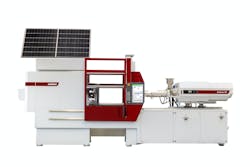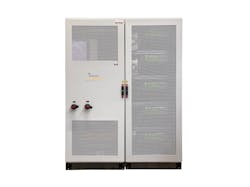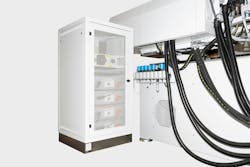Wittmann, Innovenergy create DC-powered microgrid
By Karen Hanna
Injection molding machine (IMM) maker Wittmann and a company that specializes in batteries have teamed up to bring home energy from more than 90 million miles away.
Having already introduced a direct-current (DC) IMM that has the possibility of running off solar power, Wittmann showed off at Fakuma the results of a new partnership that truly illuminates the setup’s green benefits — with a DC microgrid, called DConnect, devised by Innovenergy AG, Meiringen, Switzerland. Drawing power from an in-house solar power station and salt battery, a DC version of Wittmann’s EcoPower 180/750+ IMM and WX142 robot worked together to produce PP drainage parts.
In designing the equipment, Wittmann coupled the DC intermediate circuits of the robot and machine allowing the complete braking energy to be used, said Mario Bruckner, Wittmann’s project manager for its DC portfolio and an area sales manager for Spain, Italy and the UK.
“We have already successfully developed our EcoPower 180/750+ and the WX142 robot in DC design and can thus realize all the advantages of DC technology,” he said. “However, our products require a DC infrastructure, i.e., a so-called DC grid, in order to be operated. And this is where our partner Innovenergy comes into [the] game with the DConnect system and the Salimax salt battery storage system.”
Wittmann’s partnership with Innovenergy began in the second quarter of this year, said Bruckner, who expects sales in Europe to begin in the second quarter of 2024. Currently, there are no plans for a U.S. introduction.
Bruckner said Innovenergy’s systems overcome the challenges of pairing alternating current (AC) systems with photovoltaic systems, which produce DC power. Because battery storage systems like Innovenergy’s use direct current, there’s no need to convert between direct and alternating current — a process that wastes energy.
According to Bruckner from Wittmann, DC/AC/DC conversion losses between the solar power station and the machine can be reduced by up to 15 percent. With the DConnect system, users can take advantage of the potential of rooftop photovoltaic systems without having to invest in a main connection extension.
At Fakuma, the work cell drew from a battery cabinet of electro-chemical capacitors, known as super-caps, which are needed to compensate for the IMM’s short-term load peaks, and Innovenergy’s sodium-nickel Salimax storage batteries, designed for handling peak periods. According to Wittmann, the battery cabinet supplied more than enough power for continuous operation throughout the show’s 8-hour days.
Depending on the capacity of the battery cabinet — they’re available in 45-kilowatt-hour increments — the storage systems can help users store solar energy and cover peak loads, when costs are highest. Users might even be able to maintain regular operations. The system also can increase energy efficiency and reduce carbon dioxide emissions.
Innovenergy plans to train and support local AC network planners and installation partners, so they know how to pair existing AC systems with DC microgrids.
“Our Wittmann DC equipment has been developed and adapted for DC operation. The infrastructure of Innovenergy is designed to the needs of our equipment so that it runs in an optimal operation,” Bruckner said.
As standard, Wittmann’s EcoPower IMM comes with a kinetic energy recovery system, which converts kinetic energy into electric energy during deceleration processes, using the resulting current within the machine for processes like barrel heating. The energy also can be fed back into the DC system.
In an email, Bruckner noted that the system’s advantages go beyond energy.
“For the cabling of DC networks, up to 50 percent copper and 25 percent insulation material can be saved for the same power, since DC networks use a three-wire system ... and not a four- or five-wire system as with AC. Integrated battery storage in a DC grid increases the security of power supply and thus ensures safe production operations. Innovenergy uses salt battery storage, which is 100 percent recyclable, non-flammable, non-explosive and made only of harmless materials,” he said.
Contact:
Wittmann Group, Torrington, Conn., 860-496-9603, www.wittmann-group.com/en/usa
About the Author
Karen Hanna
Senior Staff Reporter
Senior Staff Reporter Karen Hanna covers injection molding, molds and tooling, processors, workforce and other topics, and writes features including In Other Words and Problem Solved for Plastics Machinery & Manufacturing, Plastics Recycling and The Journal of Blow Molding. She has more than 15 years of experience in daily and magazine journalism.


